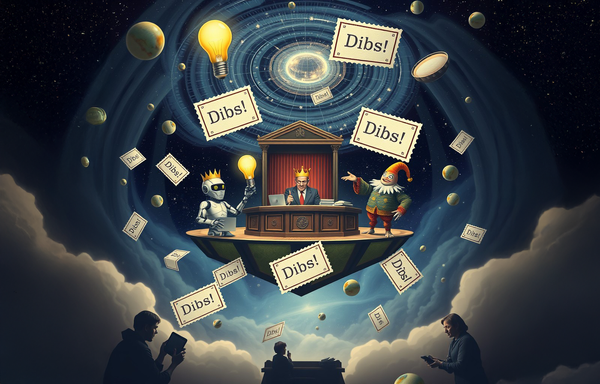Navigating the Challenges of Misinformation with C2PA 🔮
"Predicting the future isn’t magic. It’s artificial intelligence.”
— David Waters


The Rise of Misinformation
In an era where information is readily accessible, the spread of misinformation has become rampant. The democratization of information on the internet has allowed both reliable and deceptive content to flourish. From false news articles to manipulated images and deepfake videos, separating truth from falsehood has become increasingly difficult. The future of "truth" on the internet is a complex interplay between authenticity, privacy, and power.
Understanding the C2PA Standard
What is C2PA and Tracing Media Origin?
The Coalition for Content Provenance and Authenticity (C2PA) is a new initiative by companies like Adobe and Microsoft, aimed at protecting digital content from replication and tampering. C2PA utilizes metadata and digital signatures to make files tamper aware, urging the US Senate to legislate anti-impersonation technology. Additionally, the US Department of Defense is introducing technology that can identify bad actors and ensure people's safety, but raises concerns about potential mass surveillance. The C2PA establishes an open technical standard, enabling the traceability of media origin with absolute confidence.
Tracing media origin is crucial in the digital age. It allows us to authenticate the news and online videos we consume daily. By establishing a traceable path back to the source of a media file, we can ensure the credibility of the information we obtain. However, tracing media origin goes beyond authenticity verification. It also plays a vital role in copyright protection, giving appropriate credit to creators, and preventing the dissemination of misinforming content.
How Provenance Works in Tracing Media Origin
Provenance is a concept that identifies the original source or creator of digital content. It serves as a "breadcrumb trail" that can be used to verify the authenticity of an image, video, or audio file and detect any alterations made along the way.

What is the CAI (Content Authenticity Initiative)?
The Content Authenticity Initiative (CAI) is a key component of tracing media origin. It is a secure end-to-end system for digital content provenance through open-source development, cross-industry collaboration, and interoperability of tools. An initiative launched by Adobe, Twitter, and The New York Times to establish a standardized system for verifying the authenticity of digital content and ensuring proper credit for creators .
Following a piece of content from capture to edit to publish or sharing on social media below.

1. CREATION
Cryptographic asset hashing is used to provide verifiable, tamper-evident signatures that the image and metadata hasn’t been unknowingly altered. At creation, choose what information to attach to the content being created. Throughout this process, the creator of content can choose to preserve attribution or to remain anonymous. Privacy and security of photojournalists and other creators are of the utmost consideration in our work.
2. EDITING
Using tools like Photoshop, secure capture metadata will be preserved and amended with history data of any alterations to content.
3. PUBLISHING
Through partnerships with news organizations, see secure capture information and any relevant content edits preserved through the publishing process, through integration with publishers’ CMS. When content is shared on social networks, the product flow will preserve CAI metadata.
4. VIEWING
As a consumer of digital content, anyone can view historical information about content with CAI metadata through the Verify site.
Benefits of Tracing Media Origin

Ensuring Authenticity and Trustworthiness
Tracing media origin provides a critical benefit by verifying the authenticity of digital content. In an era of misinformation, it is vital to establish the legitimacy of what we read. By tracing media sources, we can ensure accurate and trustworthy information, fostering a sense of trust.
Protecting Against Misinformation and Manipulation
Tracing media origin also serves as an effective defense against misinformation and manipulation. By identifying the source of content, it becomes easier to recognize and challenge attempts to spread false data or shape public opinion. This is especially crucial in the realm of politics, which is often plagued by disinformation campaigns.
Helping Creators Get Proper Credit
For creators, tracing media origin ensures they receive adequate credit for their work. It enables them to protect their intellectual property and discourages unauthorized use or plagiarism. By recognizing and rewarding originality and talent, tracing media origin fosters a healthier and fairer creative ecosystem.

The Importance of Copyright Enforcement
Tracing media origin plays a vital role in facilitating copyright enforcement. By establishing a definitive connection between the content's creator and the material, it simplifies the process of finding and punishing violations of copyright law. This not only safeguards creators' rights but also promotes respect for intellectual property in the digital age.


Implementing and Using C2PA
How to Add Provenance to Images, Videos, and Audio
Adding provenance to images, videos, and audio involves embedding metadata into the digital files. This metadata includes information about the creator, the creation process, and any subsequent modifications to the content. By maintaining this data, it becomes possible to trace the origin and verify the authenticity of digital media.

Tools and Technologies for Tracing Media Origin
Various tools and technologies are available to assist with tracing media origin. These range from simple metadata editors to sophisticated software solutions that can analyze and verify the provenance of digital content. The choice of tools depends on the specific needs and requirements of the user, whether they are a content creator, publisher, or consumer.

Working with the C2PA Consortium
The C2PA consortium is open to collaboration with other organizations and individuals interested in promoting authenticity and trust in the digital media landscape. By working together, we can develop more robust standards and tools for tracing media origin, ensuring that the digital ecosystem remains fair, transparent, and trustworthy.


Potential Challenges and Concerns
The Role of Media Literacy
Media literacy plays a crucial role in combating misinformation. Educating individuals on how to critically evaluate information, fact-check sources, and recognize signs of deceptive content is essential. By equipping users with the tools to be discerning consumers of information, we can build a more resilient society against the spread of misinformation.
The Threat of Deepfakes
One of the most significant challenges in tracing media origin is the rise of deepfakes. Deepfakes are highly sophisticated manipulated videos that use artificial intelligence to alter content and make it appear authentic. These videos have the potential to deceive audiences, manipulate public perception, and harm individuals. Urgent action is needed to address the threat posed by deepfakes.
Balancing Privacy and Transparency
While tracing media origin brings many benefits, there is a need to balance privacy concerns with the desire for transparency. The collection and storage of metadata raise questions about data privacy and control. Striking a balance between authenticity and privacy is critical to ensuring individuals' rights and security while effectively combating misinformation.
Addressing Technical Limitations
Tracing media origin is not without its technical limitations. As technology advances, methods used to manipulate and alter digital content also evolve. There will always be challenges in detecting sophisticated deepfake videos or edited images that can fool even the most advanced algorithms. Ongoing research and development are necessary to stay one step ahead of those who seek to deceive through technological advancements.
Overcoming Adoption Hurdles
For tracing media origin to be truly effective, widespread adoption is crucial. Encouraging content creators, publishers, and consumers to embrace the C2PA standard and use tools for verifying media provenance may require education and awareness campaigns. Overcoming resistance and inertia in the industry will be an ongoing challenge, but it is necessary to ensure the integrity of the digital media landscape.
The Challenge of Enforcement
While initiatives like the C2PA are commendable, the enforcement of content authenticity standards poses challenges. With the vast amount of content uploaded to the internet every minute, it becomes a daunting task to verify the authenticity of all media. Moreover, those intent on spreading misinformation may find ways to circumvent the verification process, rendering it less effective in countering deceptive content. Collaborative efforts and technological advancements are needed to address these enforcement challenges.


Future Developments and Applications
Advancements in Tracing Media Origin Technology
The field of tracing media origin is continuously evolving, driven by advancements in technology. Researchers and developers are exploring the use of blockchain and AI to improve the accuracy and trustworthiness of digital media authenticity tracking. These technologies have the potential to transform the process in the years to come, providing more robust solutions for tracing media origin.

Potential Impact on Journalism, Entertainment, and Advertising
Tracing media origin has significant implications for journalism, entertainment, and advertising. In journalism, it can help identify false news and ensure readers have access to accurate information. By tracing the origin of media files, journalists can validate sources and prevent the spread of misinformation. In the entertainment industry, tracing media origin can protect intellectual property rights and prevent unauthorized distribution of copyrighted content, safeguarding the creative efforts of artists and content creators. In advertising, it can enhance transparency and consumer trust by ensuring that advertisements are authentic and trustworthy, building credibility for brands and advertisers.
Navigating the Digital Landscape
As individuals, we play a crucial role in shaping the future of truth on the internet. By being vigilant, questioning the sources of information, and seeking reliable content, we can create a demand for accuracy and authenticity online. Supporting initiatives like the C2PA and advocating for increased media literacy can drive positive change in combating misinformation and restoring trust in online information.
Token Wisdom
In the digital age, we are all responsible for the information we consume and share. As digital citizens, it is our duty to engage with content critically, seek reliable sources, and refrain from contributing to the spread of misinformation. By upholding the values of truth, integrity, and responsibility, we can collectively navigate the challenges of the future of "truth" on the internet and create a more trustworthy online ecosystem.
Throughout this overview of the future of truth on the internet, we have explored the rise of misinformation, the challenges it poses in the digital landscape, and the potential solutions offered by initiatives like the C2PA and the Content Authenticity Initiative (CAI). These initiatives, driven by technological advancements in tracing media origin, aim to establish standards, utilize metadata, and leverage collaborative efforts to create a more transparent and accountable online environment.

The Responsibility of Digital Citizenship
By establishing a traceable path back to the source of digital content, these initiatives facilitate authenticity verification, protect against misinformation and manipulation, and help creators receive proper credit for their work. They also play a vital role in copyright enforcement, ensuring respect for intellectual property in the digital age.
However, it is essential to recognize that these measures are not foolproof. The battle against misinformation requires continuous vigilance and critical thinking from individuals. Widespread adoption and collaboration among stakeholders, including social media platforms, tech companies, and content creators, are crucial for the success of these initiatives. Only through collective efforts can we truly address the challenges posed by deepfakes, privacy concerns, technical limitations, and enforcement hurdles. The world keeps innovating, advancements in technology, such as blockchain and AI, hold promise for further improving the accuracy and trustworthiness of digital media authenticity tracking. These future developments can have significant implications for journalism, entertainment, advertising, and society as a whole. However, it is crucial to navigate this evolving digital landscape with caution and to remain committed to responsible digital citizenship.
As we conclude, the future of truth on the internet lies in our collective hands. By embracing initiatives like the C2PA and the CAI, advocating for increased media literacy, and demanding accuracy and authenticity online, we can pave the way for a more trustworthy online ecosystem. Let us remain steadfast in upholding the values of truth, integrity, and responsibility as we confront the challenges of the digital age and strive to create a more trustworthy online ecosystem.
Together, we can navigate the complexities of the digital landscape, combat misinformation, and ensure that truth prevails. By taking responsibility for the information we consume and share, by supporting initiatives that promote transparency and accountability, and by fostering a culture of critical thinking and media literacy, we can shape a future where the internet is a reliable source of truth and knowledge. Let us embrace this opportunity to drive positive change and build a digital world we can trust.
———
For more information with regards to C2PA or CAI, please click on their respective links or choose to get started with content authenticity and digital provenance tools in this hour long video.







Member discussion